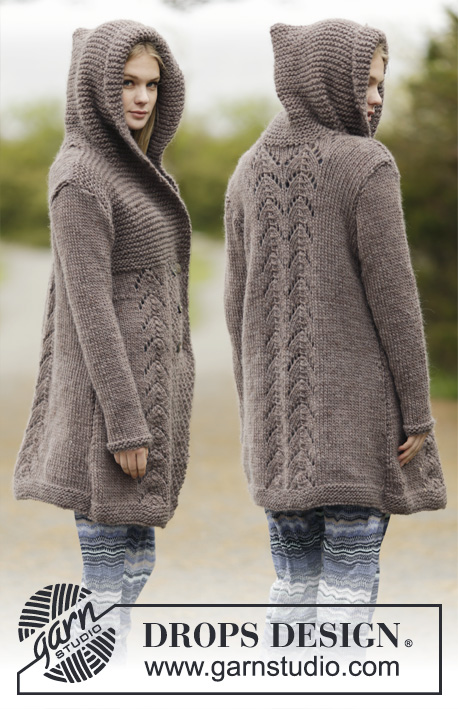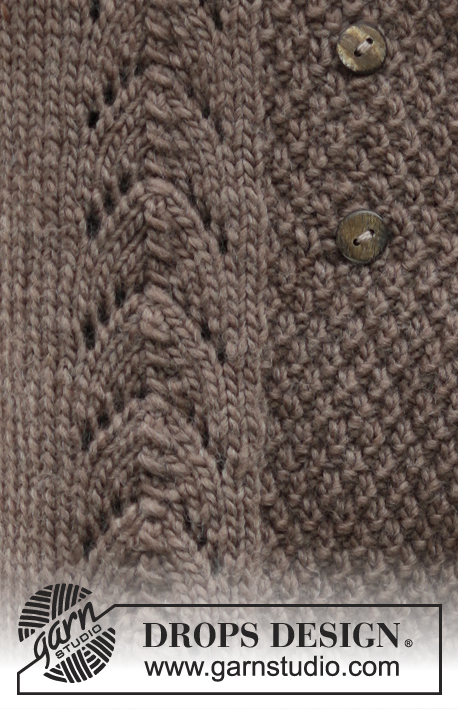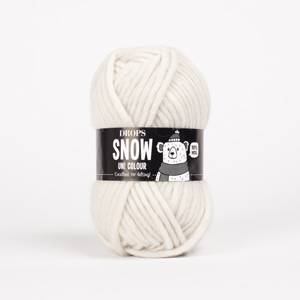Comments / Questions (112)
![]() SILVIE wrote:
SILVIE wrote:
Hallo liebes Drops Team...ich bin jetzt beim ersten Vorderteil angelangt aber es sieht für mich merkwürdig aus, weil das große Perlmuster viel höher erscheint als das kraus rechts gestrickte Bündchen..gleicht sich das irgendwie noch aus? Nach 3 Reihen glatt rechts über dem kraus Bündchen beträgt die Höhendifferenz bei mir schon 2 cm...und ich denke, das könnte im Verlauf noch mehr werden...was mache ich falsch? Lg
16.12.2024 - 00:36DROPS Design answered:
Liebe Sylvie, wenn der Unterschied zwischen A.1/Perlmuster und Krausrechte untere Blende zu groß ist, dann können Sie verkürzten Reihen stricken, dh nur die Krausrechte Maschen stricken (nicht die Blende), so können Sie diesen Unterschied vermindern. Viel Spaß beim Stricken!
16.12.2024 - 11:22
![]() Katharina wrote:
Katharina wrote:
Hallo, Die Grösse xxxl entspricht welcher Grösse?mfg Katharina
21.11.2024 - 10:23DROPS Design answered:
Liebe Katharina, um die richtige Größe zu finden, messen Sie eine ähnliche Jacke, die Sie gerne tragen und vergleichen Sie die Maßnahmen mit den in der Maßskizze - hier lesen Sie mehr. Viel Spaß beim Stricken!
21.11.2024 - 15:37
![]() Irene Manuela Guerrero wrote:
Irene Manuela Guerrero wrote:
Me encantaría aprender a tejer con este sistema, sólo conozco las agujas rectas y el crochet, éste sistema sin costura me encantaría, vivo en España Gerona y no creo que consiga estas agujas, no? Gracias
18.10.2023 - 05:55
![]() Jolanda Baltus wrote:
Jolanda Baltus wrote:
Bij de beschryving van het rechtervoorpand, is de mindering voor de mouwinzet niet opgenomen. Het is even puzzelen, verder mooi patroon, nog wel twee extra knoopsgaten meegenomen :)
17.01.2023 - 10:16
![]() Lisa Robert wrote:
Lisa Robert wrote:
Rabattre maintenant pour les emmanchures au début de chaque rang de chaque côté: 1 fois 3 m, 0-0-1-2-3-4 fois 2 m et 1-2-2-3-3-3 fois 1 m = 39-41-43-43-45-47 m. A cette partie du tricot je suis a 57m si je rabats comme indiqué je ne trouve pas 43m je crois que je ne comprends pas bien cette partie du patron, pouvez-voue m'expliquer s'il vous plait?
25.10.2022 - 09:51DROPS Design answered:
Bonjour Mme Robert, en taille L, vous allez rabattre 3 m au début des 2 rangs suivants (= à la fin du rang suivant sur l'endroit + à la fin du rang suivant sur l'envers) (= 3 m de chaque côté), puis 2 mailles au début des 2 rangs suivants (= 2 m de chaque côté) et enfin 1 maille au début des 4 rangs suivants (2 m de chaque côté) vous avez ainsi rabattu 3+2+2 = 7 m de chaque côté soit: 57-14=43 mailles. Bon tricot!
25.10.2022 - 13:13
![]() Anna wrote:
Anna wrote:
Woher stammt die Wolle bzw. ist sie aus artgerechter Haltung gewonnen? Kann ich zu viel bestelltes Garn umtauschen?
22.10.2022 - 10:06DROPS Design answered:
Liebe Anna, mehr übere unsere Wollen können Sie hier und auch hier lesen - über Umtauschen wenden Sie sich bitte direkt an Ihrem DROPS Händler an, dort wird man Ihnen am besten helfen. Viel Spaß beim stricken!
24.10.2022 - 07:53
![]() Lisa Robert wrote:
Lisa Robert wrote:
Bonjour, j'aimerai beaucoup essayer de tricoter ce modèle mais je ne vois pas le nombre de pelotes qu'il faut prendre pour une taille M. Merci de votre aide
26.09.2022 - 06:53DROPS Design answered:
Bonjour Mme Robert, vous trouverez la quantité nécessaire pour chaque taille dans l'en-tête, avec les tailles, les aiguilles et l'échantillon; autrement dit, en taille M, il vous faudra 1050 g DROPS Snow / 50 g la pelote = 21 pelotes. Bon tricot!
26.09.2022 - 11:31
![]() Sabrina Schmidt wrote:
Sabrina Schmidt wrote:
Hallo. Ich habe Probleme beim Annähen der Ärmel. Ich habe mehr Ärmelmaschen als Armausschnittsmaschen und somit passt es leider nicht. Bei der Anleitung der Ärmel steht am Ende: Die restlichen M abketten, die Arb hat eine Gesamtlänge von ca. 56-57-57-57-57-57 cm. Den 2. Ärmel ebenso str. Wie viel sind denn die restlichen Maschen? Bei mir sind es 10 Maschen. Ist das korrekt oder habe ich hier den Fehler, dass die Ärmel nicht passen? Vielen Dank
21.01.2022 - 14:55DROPS Design answered:
Liebe Frau Schmidt, die restlichen Maschenanzahl kann je nach Ihrer Maschenprobe in der Höhe unterschiedlich sein, wichtig ist hier die cm-Angaben, damit alle stimmen. Vesuchen Sie die Ärmel mit Stecknadel in das Armloch zu platzieren, es kann sicher helfen. Viel Spaß beim stricken!
21.01.2022 - 16:08
![]() Sabrina Schmidt wrote:
Sabrina Schmidt wrote:
Hallo. Ich habe heute eine Frage geschickt aber ich habe mein Problem gerade selbst klären können. Vielen Dank trotzdem.
18.01.2022 - 15:13
![]() Sabrina Schmidt wrote:
Sabrina Schmidt wrote:
Hallo. Ich bin bei den Ärmeln: Bei einer Gesamtlänge von 8-8-8-8-10-12 cm je 1 M beidseitig zunehmen . Bei Zunahmetipp steht: Es wird neben 1 kraus-re-Rand-M und 1 re-M zugenommen (d.h. neben 2 M), indem 1 Umschlag gearb wird. Wird denn hier nur am Anfang der Reihe zugenommen oder auch am Reihenende. Müsste ja so sein, da 2 Ma pro Reihe zugenommen werden, oder? Auf der Zeichnung der Ärmel sehe ich aber nur eine Zunahmeschräge an einer Seite. Vielen Dank vorab. Sabrina
18.01.2022 - 11:52DROPS Design answered:
Liebe Frau Schmidt, bei den Ärmel werden 2 Maschen (1 auf beide Seite = die erste nach der Randmaschen+ 1 Masche und die andere vor 1 Masche + der Randmaschen) zugenommen - bei der Skizze liegt die Ärmel flach = Die Schrägseite ist dann unten (mitte unter die Ärmel). Viel Spaß beim stricken!
18.01.2022 - 14:11
Into The Woods#intothewoodsjacket |
|||||||||||||
 |
 |
||||||||||||
Knitted DROPS jacket in garter st, double seed st and lace pattern with hood in ”Snow”. Size: S - XXXL.
DROPS 164-1 |
|||||||||||||
|
GARTER ST (back and forth): K all rows. 1 ridge = K2 rows. PATTERN: See diagram A.1 and A.2 (choose diagram for correct size). The diagrams show all rows in pattern seen from RS. DECREASE TIP: All dec are done from RS! Dec inside 1 st K and 1 edge st in garter st. Dec as follows when 2 sts remain before 1 K st and 1 edge st in garter st: K 2 tog. Dec as follows after 1 sts in garter st and 1 sts: Slip 1 st as if to K, K 1, psso. INCREASE TIP: All inc are done from RS. Inc inside 1 edge st in garter st and 1 K by making 1 YO. On next row P YO twisted to avoid holes. MEASURING TIP 1 (applies for body and back piece): To get the correct proportions on the jacket make all length measurements when work lies flat. Because of the weight of the yarn and the garter sts on the yoke the work will stretch approx. 10 cm / 4'' in total length to what is shown on the schematic drawing. MEASURING TIP 2 (applies for sleeves): Because of the weight of the yarn make all length measurements while holding the piece up. BUTTONHOLES: Dec for 6 buttonholes on right front piece (from RS): Work 4 sts, bind off 2 sts for button hole, work 6-6-6-8-8-8 sts, cast of the next 2 sts for buttonhole = 2 buttonholes on same row (4 sts remain on band). On next row cast on 2 new sts over the bind off sts. Dec for buttonholes when piece measures: SIZE S: 36, 45, 54 cm / 14 1/4", 17 3/4", 21 1/4" SIZE M: 38, 47, 56 cm / 15", 18½", 22'' SIZE L: 40, 49, 58 cm / 15 3/4", 19 1/4", 22 3/4" SIZE XL: 42, 51, 60 cm / 16½", 20", 23½" SIZE XXL: 44, 53, 62 cm / 17 1/4", 21", 24½" SIZE XXXL: 46, 55, 64 cm / 18", 21½", 25 1/4" NOTE: Approx. 1 cm / ½'' remains after last buttonhole before working in garter st over all sts. (on band). ---------------------------------------------------------- BACK PIECE: The piece is worked back and forth on circular needle because of no of sts. Cast on 61-65-71-75-81-87 sts (includes 1 edge st in each side) on circular needle size 7 mm / US 10.75 with Snow. Work in GARTER ST - see explanation above, for 5-5-5-6-6-6 cm / 2''-2''-2''-2 3/8''-2 3/8''-2 3/8'' (1st row = RS). Switch to circular needle size 8 mm / US 11 and work next row from RS as follows: 1 edge st in garter st, 20-22-23-25-26-29 sts in stockinette st, work pattern according to diagram A.2 2 times in total (choose diagram for correct size = 2 repetitions of 10-10-12-12-14-14 sts), work in stockinette st until 1 st remains on row and finish with 1 edge st in garter st. Continue like this with stockinette st, pattern and 1 edge st in garter st in each side. REMEMBER THE KNITTING GAUGE When piece measures 8-8-8-10-10-10 cm / 3"-3"-3"-4"-4"-4'', dec 1 st in each side - READ DECREASE TIP (= 2 sts dec) and MEASURING TIP 1. Repeat dec in each side every 7-7-8-10-10-10 cm / 2 3/4"-2 3/4"-3"-4"-4"-4'' a total of 7-7-7-6-6-6 times = 47-51-57-63-69-75 sts. Continue to work until piece measures 61-63-65-67-69-71 cm / 24''-24¾''-25½''-26 3/8''-27 1/8''-28''. Now bind off for armholes at beg of every row in each side as follows: bind off 3 sts 1 time, 2 sts 0-0-1-2-3-4 times and 1 st 1-2-2-3-3-3 times = 39-41-43-43-45-47 sts. When piece measures 78-81-84-87-90-93 cm / 30 3/4"-32"-33"-34 1/4"-35½"-36½", bind off the middle 9-9-11-11-11-13 sts for neck and finish each shoulder separately. Continue to bind off 1 st on next row from neck = 14-15-15-15-16-16 sts remain on the shoulder. Loosely bind off all sts when piece measures 80-83-86-89-92-95 cm / 31½''-32¾''-33 7/8''-35''-36¼''-37 3/8''. Repeat on the other shoulder. RIGHT FRONT PIECE: Worked back and forth on circular needle. Cast on 40-42-44-48-52-54 sts (includes 1 edge st in the side and 18-18-18-20-20-20 band sts towards mid front) on circular needle size 7 mm / US 10.75 with Snow. Work first row as follows from RS: Work A.1 over the first 18-18-18-20-20-20 sts (= band), then work in garter st over the remaining 22-24-26-28-32-34 sts. Continue with A.1 over band and garter st over the remaining sts for 5-5-5-6-6-6 cm / 2''-2''-2''-2 3/8''-2 3/8''-2 3/8''. Switch to circular needle size 8 mm / US 11 and work next row from RS as follows: A.1 over the first 18-18-18-20-20-20 sts as before, 2 sts in stockinette st, work A.2 (choose diagram for correct size = 1 repetition of 10-10-12-12-14-14 sts), work in stockinette st until 1 st remains on row and finish with 1 edge st in garter st. Continue like this with stockinette st, pattern and 1 edge st in garter st towards the side. When piece measures 8-8-8-10-10-10 cm / 3"-3"-3"-4"-4"-4'', dec in the side as on back piece. Repeat dec 7-7-7-6-6-6 times in total = 33-35-37-42-46-48 sts. AT THE SAME TIME when piece measures 36-38-40-42-44-46 cm / 14¼''-15''-15¾''-16½''-17¼''-18'', dec for BUTTONHOLES - see explanation above. When piece measures 55-57-59-61-63-65 cm / 21 5/8''-22½''-23¼''-24''-24¾''-25½" - REMEMBER MEASURING TIP 1, work in garter st over all sts (also over the 18-18-18-20-20-20 band sts) until finished measurements. AT THE SAME TIME when piece measures 61-63-65-67-69-71 cm / 24''-24¾''-25½''-26 3/8''-27 1/8''-28'', bind off for armhole at beg of every row from the side as on back piece = 29-30-30-32-34-34 sts on needle. When piece measures 74-77-80-82-85-88 cm / 29"-30½"-31½"-32 1/4"-33½"-34½", slip the outermost 11-11-11-12-13-13 sts towards mid front on 1 stitch holder for neck (work them before slipping them on stitch holder to avoid cutting the yarn). Continue to bind off for neck at beg of every row from neck as follows: bind off 2 sts 1 time and then 1 st 2-2-2-3-3-3 times in total = 14-15-15-15-16-16 sts remain on shoulder. Loosely bind off all sts when piece measures 80-83-86-89-92-95 cm / 31½''-32¾''-33 7/8''-35''-36¼''-37 3/8''. LEFT FRONT PIECE: Cast on and work as right front piece but reversed. NOTE: Beg A.2 as follows from RS: Work 1 edge st in garter st, work in stockinette st until 29-29-31-33-35-35 sts remain on row, work pattern according to diagram A.2 (choose diagram for correct size = 1 repetition of 10-10-12-12-14-14 sts), work 1 st in stockinette st and continue A.1 over the remaining 18-18-18-20-20-20 sts (= band). Do not dec for buttonholes on left front piece. ASSEMBLY: Sew the shoulder seams. HOOD: Pick up approx. 46 to 58 sts around the neck (includes sts on stitch holders at the front) on circular needle size 8 mm / US 11 with Snow. K 1 row from WS while inc evenly to 66-68-70-72-74-76 sts - do not inc over bands. Then work in garter st back and forth over all sts until hood measures approx. 32-33-34-35-36-37 cm / 12½''-13½''-13 3/8''-13¾''-14¼''-14½''. Bind off. Fold the hood double and sew tog at the top with grafting/kitchener sts. SLEEVE: Worked back and forth on circular needle. Cast on 26-28-30-30-34-34 (includes 1 edge st in each side) on circular needle size 7 mm / US 10.75 with Snow. Work 2 ridges. Switch to circular needle size 8 mm / US 11 and work in stockinette st with 1 edge st in garter st in each side. When piece measures 8-8-8-8-10-12 cm / 3"-3"-3"-3"-4"-4 3/4", inc 1 st in each side - READ INCREASE TIP (= 2 sts inc) and MEASURING TIP 2. Repeat inc every 7½-6-6-5-4½-3½ cm / 2 7/8"-2 3/8"-2 3/8"-2"-1 3/4"-1 1/4" 6-7-7-8-8-9 times in total = 38-42-44-46-50-52 sts. When piece measures 48-48-47-45-44-43 cm / 19"-19"-18½"-17 3/4"-17 1/4"-17" (NOTE: Shorter measurements in the larger sizes because of longer sleeve cap and wider shoulders), bind off for sleeve cap at beg of every row in each side as follows: bind off 3 sts 1 time, 2 sts 1-2-2-2-2-2 time and 1 st 2-2-3-3-3-3 times. Then bind off 2 sts at beg of every row in each side until piece measures approx. 55-56-56-56-56-56 cm / 21½"-22"-22"-22"-22"-22", then bind off 3 sts 1 time in each side. Bind off the remaining sts, piece measures approx. 56-57-57-57-57-57 cm / 22"-22½"-22½"-22½"-22½"-22½". Make another sleeve. ASSEMBLY: Sew in the sleeves inside 1 edge st. Sew underarm and side seams in one inside 1 edge st. Sew the buttons on to left front piece. |
|||||||||||||
Diagram explanations |
|||||||||||||
|
|||||||||||||

|
|||||||||||||

|
|||||||||||||
Have you finished this pattern?Tag your pictures with #dropspattern #intothewoodsjacket or submit them to the #dropsfan gallery. Do you need help with this pattern?You'll find 28 tutorial videos, a Comments/Questions area and more by visiting the pattern on garnstudio.com. © 1982-2025 DROPS Design A/S. We reserve all rights. This document, including all its sub-sections, has copyrights. Read more about what you can do with our patterns at the bottom of each pattern on our site. |
|||||||||||||













































































Post a comment to pattern DROPS 164-1
We would love to hear what you have to say about this pattern!
If you want to leave a question, please make sure you select the correct category in the form below, to speed up the answering process. Required fields are marked *.